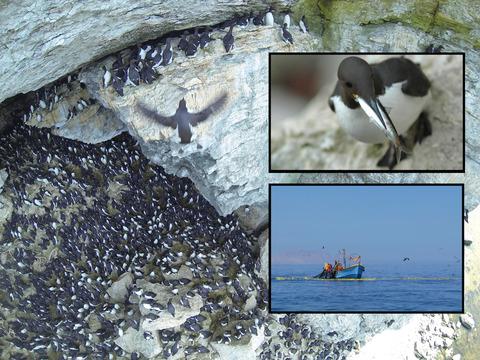当前位置:
X-MOL 学术
›
J. Appl. Ecol.
›
论文详情
Our official English website, www.x-mol.net, welcomes your
feedback! (Note: you will need to create a separate account there.)
A mechanistic framework to inform the spatial management of conflicting fisheries and top predators
Journal of Applied Ecology ( IF 5.0 ) Pub Date : 2020-10-13 , DOI: 10.1111/1365-2664.13759 Jonas Hentati‐Sundberg 1 , Agnes B. Olin 2, 3 , Tom J. Evans 4 , Natalie Isaksson 5 , Per‐Arvid Berglund 6 , Olof Olsson 7
Journal of Applied Ecology ( IF 5.0 ) Pub Date : 2020-10-13 , DOI: 10.1111/1365-2664.13759 Jonas Hentati‐Sundberg 1 , Agnes B. Olin 2, 3 , Tom J. Evans 4 , Natalie Isaksson 5 , Per‐Arvid Berglund 6 , Olof Olsson 7
Affiliation

|
Conflicts of interest between resource extraction and conservation are widespread, and negotiating such conflicts, or trade-offs, is a key issue for ecosystem managers. One such trade-off is resource competition between fisheries and marine top predators. Managing this trade-off has so far been difficult due to a lack of knowledge regarding the amount and distribution of prey required by top predators. Here, we develop a framework that can be used to address this gap: a bio-energetic model linking top predator breeding biology and foraging ecology with forage fish ecology and fisheries management. We apply the framework to a Baltic Sea colony of common guillemots Uria aalge and razorbills Alca torda, two seabird species sensitive to local prey depletion, and show that densities of forage fish (sprat Sprattus sprattus and herring Clupea harengus) corresponding to the current fisheries management target BMSY are sufficient for successful breeding. A previously proposed fisheries management target for conserving seabirds, 1/3 of historical maximum prey biomass (B1/3), was also sufficient. However, the results highlight the importance of maintaining sufficient prey densities in the vicinity of the colony, suggesting that fine-scale spatial fisheries management is necessary to maintain high seabird breeding success. Despite foraging on the same prey, razorbills could breed successfully at lower prey densities than guillemots but needed higher densities for self-maintenance, emphasizing the importance of considering species-specific traits when determining sustainable forage fish densities for top predators. Synthesis and applications. Our bio-energetic modelling framework provides spatially explicit top predator conservation targets that can be readily integrated with current fisheries management. The framework can be combined with existing management approaches such as dynamic ocean management, marine spatial planning and management strategy evaluation to inform ecosystem-based management of marine resources.
中文翻译:

为冲突渔业和顶级捕食者的空间管理提供信息的机制框架
资源开采和保护之间的利益冲突很普遍,协商此类冲突或权衡是生态系统管理者的关键问题。其中一项权衡是渔业与海洋顶级捕食者之间的资源竞争。由于缺乏关于顶级捕食者所需猎物的数量和分布的知识,到目前为止,管理这种权衡一直很困难。在这里,我们开发了一个可用于解决这一差距的框架:将顶级捕食者育种生物学和觅食生态学与饲料鱼生态学和渔业管理联系起来的生物能量模型。我们将这个框架应用于波罗的海海雀乌利亚 aalge 和 razorbills Alca torda 这两种对当地猎物消耗敏感的海鸟物种的波罗的海殖民地,并表明与当前渔业管理目标 BMSY 相对应的饲料鱼(sprattus sprattus 和鲱鱼 Clupea harengus)的密度足以成功繁殖。先前提出的保护海鸟的渔业管理目标,即历史最大猎物生物量 (B1/3) 的 1/3,也已足够。然而,结果强调了在殖民地附近保持足够的猎物密度的重要性,这表明精细空间渔业管理对于保持高海鸟繁殖成功是必要的。尽管以相同的猎物觅食,剃须鸟可以在比海鸠低的猎物密度下成功繁殖,但需要更高的密度来自我维持,强调在确定顶级捕食者的可持续饲料鱼密度时考虑物种特定性状的重要性。合成与应用。我们的生物能量建模框架提供了空间明确的顶级捕食者保护目标,可以很容易地与当前的渔业管理相结合。该框架可以与现有的管理方法相结合,例如动态海洋管理、海洋空间规划和管理战略评估,为基于生态系统的海洋资源管理提供信息。
更新日期:2020-10-13
中文翻译:

为冲突渔业和顶级捕食者的空间管理提供信息的机制框架
资源开采和保护之间的利益冲突很普遍,协商此类冲突或权衡是生态系统管理者的关键问题。其中一项权衡是渔业与海洋顶级捕食者之间的资源竞争。由于缺乏关于顶级捕食者所需猎物的数量和分布的知识,到目前为止,管理这种权衡一直很困难。在这里,我们开发了一个可用于解决这一差距的框架:将顶级捕食者育种生物学和觅食生态学与饲料鱼生态学和渔业管理联系起来的生物能量模型。我们将这个框架应用于波罗的海海雀乌利亚 aalge 和 razorbills Alca torda 这两种对当地猎物消耗敏感的海鸟物种的波罗的海殖民地,并表明与当前渔业管理目标 BMSY 相对应的饲料鱼(sprattus sprattus 和鲱鱼 Clupea harengus)的密度足以成功繁殖。先前提出的保护海鸟的渔业管理目标,即历史最大猎物生物量 (B1/3) 的 1/3,也已足够。然而,结果强调了在殖民地附近保持足够的猎物密度的重要性,这表明精细空间渔业管理对于保持高海鸟繁殖成功是必要的。尽管以相同的猎物觅食,剃须鸟可以在比海鸠低的猎物密度下成功繁殖,但需要更高的密度来自我维持,强调在确定顶级捕食者的可持续饲料鱼密度时考虑物种特定性状的重要性。合成与应用。我们的生物能量建模框架提供了空间明确的顶级捕食者保护目标,可以很容易地与当前的渔业管理相结合。该框架可以与现有的管理方法相结合,例如动态海洋管理、海洋空间规划和管理战略评估,为基于生态系统的海洋资源管理提供信息。











































 京公网安备 11010802027423号
京公网安备 11010802027423号